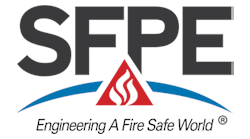Latest from Fire Sprinklers
Sponsored
By Valerie Ziavras
The digital transformation has been reshaping the way we collaborate in construction for some time now. With various stakeholders coming and going throughout the lifecycle of a building, modern digital collaboration is key in creating and maintaining a building that is safe and functional.
Think of the evolution from drafting tables to CAD and Revit software, for example. With modern software, designers can collaborate using visual aids. The software provides a platform for the team to discuss challenges and discrepancies in the design and construction process, streamlining the path to the desired final product. Now, it’s hard to imagine work before these technologies.
Codes and Standards are Going Digital, Too
Digitization is now transforming fire and life safety codes and standards in the same way. The days of lugging around clunky, sticky note-filled code books are falling behind us, and we’re ushering in a new era where we have all codes and standards at our fingertips.
Fire and life safety codes and standards permeate every aspect of the design, construction and maintenance of a facility, so it’s critical that they’re accessible, navigable and provide all stakeholders with the ability to easily collaborate. And while code books are written in black and white, anyone in the field knows that they’re living documents, and the way requirements apply to real-world scenarios is not always cut-and-dried.
Digitization helps the latest codes and standards changes, such as tentative interim amendments (TIAs), errata and formal interpretations, get disseminated quickly so everyone has access to the most up-to-date information. It also makes the codes and standards more interactive and can bring them to life with enhanced content, visual and audio aids, annotation features, sharing capabilities and more.
For contractors, this digital application can provide value in several ways by helping to coordinate across teams, document project specific requirements or equivalencies and even upskill the next generation of tradespeople.
Streamlining Precision Across Teams
Digitizing codes and standards helps contractors coordinate with one another more efficiently and accurately. Building designs may look perfect on paper, but as multiple trades come onto the site to install equipment, piping, wiring, etc., slight modifications can have a ripple effect on other trades. For example, a fire protection contractor might enter a building to find that the electrician already hung the lights, and now the sprinkler head will be too close to the lighting fixture to be compliant.
In these instances when the as-built condition is different than the planned condition, contractors can easily pull up sections of code on any device to review in-person or send via email. From there, they can confirm they’re looking at the same section of code and determine a plan to ensure safety and compliance in the building. This same coordination can also take place with AHJs during inspections or any time multiple parties need to sit down and flesh out their respective interpretations of specific codes and standards. Digitizing this process helps reduce miscommunication, resolve disagreements faster and complete projects quicker while ensuring all building and life safety aspects are accurate and up to code.
Documenting Diverse Code Requirements and Project-Specific Variances
Codes and standards requirements vary from project to project, jurisdiction to jurisdiction, etc., and it’s not uncommon for contractors to work in multiple states that enforce different editions of the code. Digital platforms grant contractors access to multiple publications and their various editions on mobile devices as small as a smartphone. And within this vast digital library, users can easily search by section or keyword across publications, bookmarking information as needed for quick access to those sections they find themselves coming back to frequently.
Additionally, there may be equivalencies permitted by the AHJ which allow for the use of alternative means to meet the intent of the code or standard. Capturing these instances in an organized, well-documented manner, however, can be a challenge. Contractors need a platform where they can house notes taken during the construction process and locate it quickly when questions arise. Luckily, digital hubs enable contractors to add searchable notes alongside sections of code to document these equivalencies. These notes can then be seamlessly handed off to facility managers so that when it comes time for inspections or renovations, there’s a digital history available.
Preserving Veteran Knowledge to Bridge the Skills Gap
As industry veterans retire and fewer young workers join and stay on jobsites, the skilled labor sector is facing a skills shortage. The construction industry will need to attract nearly 650,000 additional workers on top of the normal pace of hiring in 2022 to meet the current demand for labor, and with more than one in five construction workers over the age of 55, it’s critical to find avenues to pass down veteran knowledge and upskill the next generation of qualified tradespeople.
There’s a huge opportunity for digitized codes and standards to lend a hand in documenting veteran knowledge and sharing it with new employees. Imagine if the 45-year veteran could easily create a knowledge base to bestow his industry expertise onto new employees instead of taking his note-filled book out the door with him on retirement day. Creating a digital history ensures that expertise doesn’t disappear from the organization when its employees do.
In addition to sharing institutional knowledge, technology has also made great strides in offering interactive, accessible online training for employees seeking to advance their careers. When learning about codes and standards today, contractors can leverage videos, interactive modules, industry-specific content, situational content and more anywhere at any time. This can make training more engaging and help retain workers. Plus, off-the-page learning is great for younger, tech-savvy generations.
The Digital Future
With so many stakeholders coming and going throughout the lifecycle of a building, collaboration must expand beyond one-off emails and walks around the jobsite together to ensure the highest level of visibility, accuracy and efficiency. Contractors today need the ability to access information and communicate anywhere, anytime, on any device. The digitization of fire and life safety codes and standards empowers construction professionals to streamline collaboration, reduce miscommunication, document project-specific equivalencies, retain generational knowledge and more. By leaving physical code books in the past, we unlock a new standard of safety and efficiency.
Val Ziavras is an engineer in the NFPA technical services division where she contributes to the development of technical content for NFPA. Previously, she served as the staff liaison for the Fire Code Technical Committee and several Safety to Life and Building Code Technical Committees. Prior to joining NFPA, Val worked at a consulting engineering firm designing sprinkler systems. She received her Bachelor of Science degree in Mechanical Engineering and Master of Science degree in Fire Protection Engineering from Worcester Polytechnic Institute. Val is also a registered professional engineer in the discipline of fire protection in the Commonwealth of Massachusetts.


